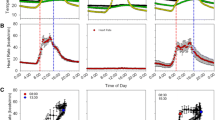Summary
Lacerta viridis maintained under natural photoperiodic conditions show daily and seasonal changes in metabolic rates and body temperature (T b) as well as seasonal differences in sensitivity to temperature change. At all times of the year lizards have a daily fluctuation in oxygen consumption, with higher metabolic rates during the light phase of the day when tested at a constant ambient temperature (T a) of 30°C. Rhythmicity of metabolic rate persists under constant darkness, but there is a decrease in the amplitude of the rhythm.
Oxygen consumption measured at various Tas shows significant seasonal differences at T as above 20°C. Expressed as the Arrhenius activation energy, metabolic sensitivity of Lacerta viridis shows temperature dependence in autumn, which changes to metabolic temperature independence in spring at T as above 20°C. The results indicate a synergic relationship between changing photoperiod and body temperature selection, resulting in seasonal metabolic adjustment and seasonal adaptation.
Similar content being viewed by others
Abbreviations
- ANOVA :
-
analysis of variance
- LD :
-
long day (16 h light)
- SD :
-
short day (8 h light)
- T a :
-
ambient temperature
- T b :
-
body temperature
References
Bennett AF, Dawson WR (1976) Metabolism. In: Gans C, Dawson WR (eds) Biology of the Reptilia, vol 5. Academic Press, New York, pp 127–223
Brattstrom BH (1965) Body temperature of reptiles. Am Midl Nat 73:376–422
Brownlie S, Loveridge JP (1983) The oxygen consumption of limbed and limbless African skinks (Sauria: Scincidae): circadian rhythms and effect of temperature. Comp Biochem Physiol 74A:643–647
Christophersen J (1973) Basic aspects of temperature action on microorganisms. In: Precht H, Christophersen J, Hensel H, Larcher W (eds) Temperature and life. Springer, Berlin Heidelberg New York, pp 3–85
Cragg PA (1978) Oxygen consumption in the lizard genus Lacerta in relation to diel variation, maximum activity, and body weight. J Exp Biol 77:33–56
Dawson WR (1975) On the physiological significance of the preferred body temperatures of reptiles. In: Gates D (ed) Biophysical ecology. Springer, New York Berlin Heidelberg, pp 443–373
Feder ME, Feder JH (1981) Diel variation of oxygen consumption in three species of Philippine gekkonid lizards. Copeia 1981 204–209
Fritzpatrick LC, Hughes JL, Venables BJ (1978) Relations between preferred body temperatures and metabolic compensation in the rusty lizard Sceloporus olivaceus. Comp Biochem Physiol 59A:13–16
Heldmaier G, Steinlechner S (1981) Seasonal control of energy requirements for thermoregulation in the Djungarian hamster (Phodopus sungorus) living in natural photoperiod. J Comp Physiol B 142:429–437
Heusner AA, Jameson EW (1981) Seasonal changes in oxygen consumption and body composition of Sceloporus occidentalis. Comp Biochem Physiol 69A:363–372
Licht P (1968) Response of the thermal preferendum and heat resistance to thermal acclimation under different photoperids in the lizard Anolis carolinensis. Am Midl Nat 79:149–158
Mautz WJ (1979) The metabolism of reclusive lizards, the Xantusiidae. Copeia 1979:577–584
Mayhew WW (1963) Temperature preference of Sceloporus orcutti. Herpetologica 18:217–233
Patterson JW, Davies PM (1978a) Energy expenditure and metabolic adaptation during winter dormancy in the lizard Lacerta vivipara jacquin. J Thermal Biol 3:183–186
Patterson JW, Davies PM (1978b) Thermal acclimation in temperate lizards. Nature 275:646–647
Patterson JW, Davies PM (1984) The influence of temperature, sexual condition, and season on the metabolic rate of the lizard Psammodromus hispanicus. J Comp Physiol B 154:311–316
Pearson SE, Stephens MA (1964) The ratio of range to standard deviation in the same normal sample. Biometrika 51:484–487
Ragland IM, Wit LC, Sellers JC (1981) Temperature acclimation in the lizards Cnemidophorus sexlineatus and Anolis carolinensis. Comp Biochem Physiol 70A:33–36
Rismiller PD, Heldmaier G (1982) The effect of photoperiod on temperature selection in the European green lizard, Lacerta viridis. Oecologia (Berl) 53:222–226
Rismiller PD, Heldmaier G (1988) How photoperiod influences body temperature selection in Lacerta viridis. Oecologia (Berl) 75:125–131
Roberts LA (1968) Oxygen consumption in the lizard Uta stansburiana. Ecology 49:809–819
Ruf T, Heldmaier G (1987) Computerized body temperature telemetry in small animals: use of simple equipment and advanced noise suppression. Comput Biol Med 17:331–340
Songdahl JH, Hutchison VH (1972) The effect of photoperiod, parietalectomy, and eye enucleation on oxygen consumption in the blue granite lizard, Sceloporus cyanogenys. Herpetologica 28:148–156
Tsuji JS (1988) Seasonal profiles of standard metabolic rate of lizards (Sceloporus occidentalis) in relation to latitude. Physiol Zool 61:230–240
Author information
Authors and Affiliations
Rights and permissions
About this article
Cite this article
Rismiller, P.D., Heldmaier, G. Seasonal changes in daily metabolic patterns of Lacerta viridis . J Comp Physiol B 161, 482–488 (1991). https://doi.org/10.1007/BF00257903
Accepted:
Issue Date:
DOI: https://doi.org/10.1007/BF00257903




